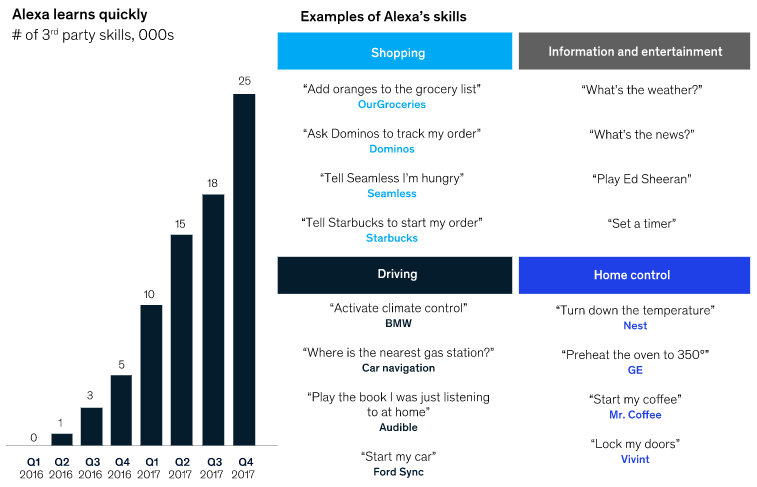A new insights report by McKinsey lays out the future of personalization, how important it is to marketing success, as well as ways businesses can prepare to compete and flourish in this smart new world.
Published in June, The future of personalization—and how to get ready for it, offers some intriguing predictions about the rise of personalized experiences among consumers.
Of course, marketing technology will be fundamental to this. In this post, I’ll highlight my own takes on where martech fits into the future McKinsey envisage.
The business value of personalization
The jump-off point for McKinsey on the growing importance of personalization comes from research published by Harvard Business Review back in 2015.
It found that companies which are leading the charge on personalization are seeing ‘5 to 15 percent increases in revenue and 10 to 30 percent increases in marketing-spend efficiency.’
But more recent data is even more illuminating. In April this year Tata Consultancy Services found that best-performing marketers are introducing personalization earlier in the customer journey than those which are under-performing.
It found that ‘86% of leaders are more likely to personalize communications with useful product/service information in the awareness stage (compared to 59% of followers).’ And when asked about their predictions on personalization in the future, ‘42% of leaders vs 20% of followers believe that in 2020 digitally personalized communications will be most important for current customers in the support and retention stages.’
From ultra-personalization online, to ultra-personalization offline
While customer experiences that are happening online are clearly becoming more personal, McKinsey also highlights the use of martech tools such as analytics data to personalize the offline consumer journey too.
According to their research, 44 percent of CMOs say that frontline employees will rely on insights from advanced analytics to provide a personalized offering. Additionally, 40 percent say that personal shoppers will use AI-enabled tools to improve service and 37 percent say that facial recognition, location recognition, and biometric sensors will become more prevalent.
Leading retailers are already trialing much of these latter AI-enabled tools – especially paired with mobile devices. Branded cell phone apps have long been used to initiate GPS-triggered push notifications of in-store offers when consumers are in the vicinity. But perhaps the more interesting trend is in the added assistance this tech is giving retail staff, where they can access customer information via their own personal devices before approaching and when in conversation with browsing shoppers.
Data-fueled AI: improving at lightning speeds
The report also looks at the evolution of digital assistants in the home, as another context in which digital personalization can play a bigger part in the offline world. According to McKinsey & Company, artificial intelligence of these technologies, such as Amazon Echo, is improving at an incredible rate.

By Q4 2017, Alexa boasted in the region of 25,000 3rd party skills – up from just 5,000 at the same time the previous year.
We can expect, that as data and analytics martech proliferates, the personalized customer experience will increasingly be something that is as associated with the home as it is the store.
McKinsey’s five steps for brand focus
The report also has some suggestions as to where brands need to focus in order to be proactive on their personalization journey. Briefly, they are:
- Invest in customer data and analytics foundations. Such as a centralized Customer-Data Platform (CDP) and a product management team put in place to build a martech roadmap with representation from IT and marketing departments.
- Find and train translators and advanced tech talent. New skills are now about more than hiring/training data scientists and engineers. Analytics translators, for example, are increasingly important to help communicate business goals to stakeholders. AI talent is also a growing skills requirement, with the majority of digitally advanced companies building their AI in house.
- Build up agile capabilities. Establish cross-functional teams. Budgeting and strategy should be more flexible.
- Protect customer privacy. Be proactive and go out of your way to ensure customer data is safe. Consumers need to be able to trust that the companies they use are getting this right.
- Get started.
Takeaways
The future of personalization—and how to get ready for it is a fascinating read for marketers at all levels of investment when it comes to martech.
Crucially, it tells us personalization is happening earlier in customer journeys than it ever has done. And those who are succeeding are aware that it is growing to become increasingly significant at the support and retention stages too.
We can also see that while personalization has long been associated with online, it is proliferating offline too – via mobile and IOT devices. Stores are well established touchpoints for personalization, but the home is becoming another context too where personalized digital content is becoming increasingly prevalent.
As is mentioned in the report’s fives steps for brand focus, analytics and data martech are fundamental to an increasingly personalized world. Want to win in personalization? Invest in CDPs which can automate data capture, process analytics of customer journeys across touchpoints, and execute campaigns in real time.
But perhaps the even bigger step businesses need to take is not in the technologies themselves, but ensuring that staff have the skills needed, and are sufficiently organized, to implement these personalization technologies. Whether it is having the capacity to implement a martech strategy, to communicate the value of analytics and data to stakeholders, or to utilize the latest personalization tools to give customers the best experience when they are shopping in-store – there are many areas in which a skilled, informed workforce will be needed as the world becomes more personalized.









